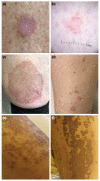Porokeratosis is one of the most common genodermatoses and is associated with an increased risk of keratinocyte cancer and melanoma
- PMID: 36152004
- PMCID: PMC10092613
- DOI: 10.1111/jdv.18587
Porokeratosis is one of the most common genodermatoses and is associated with an increased risk of keratinocyte cancer and melanoma
Abstract
Background: Porokeratosis is a clinically heterogeneous group of keratinization disorders with a genetic background mainly affecting the mevalonate pathway, which is involved in the synthesis of cholesterol, an essential component for the formation of the extracellular lipid lamellae in the stratum corneum. Porokeratosis is reportedly associated with an increased risk of keratinocyte cancer, but to date, no large epidemiological studies have been conducted to further address this association.
Objectives: The first objective was to characterize a cohort of patients diagnosed with porokeratosis at the Department of Dermatology and Venereology, Sahlgrenska University Hospital (SU), Gothenburg, Sweden. The second objective was to conduct a nationwide registry-based cohort study to investigate the association, if any, between porokeratosis and the cutaneous malignancies squamous cell carcinoma (SCC), basal cell carcinoma (BCC) and melanoma.
Methods: For the SU cohort, the hospital registry was searched for patients with a diagnosis of porokeratosis recorded between 2016 and 2020. Clinical data were extracted from the records of the identified patients. For the nationwide cohort, national registries were searched to identify patients with a diagnosis of porokeratosis between 2001 and 2020. A tenfold control cohort was formed by Statistics Sweden. The data was cross-referenced with the Swedish Cancer Register to study the associations between porokeratosis and SCC, BCC and melanoma.
Results: Disseminated superficial actinic porokeratosis was the most common clinical type among the 108 patients in the SU cohort. In the nationwide search, 2277 patients with porokeratosis were identified (prevalence 1/4132). Porokeratosis was associated with an increased risk for SCC, BCC and melanoma with hazard ratios (95% CI) of 4.3 (3.4-5.4), 2.42 (1.97-2.98) and 1.83 (1.18-2.82), respectively, in the patient cohort, compared to the matched control group.
Conclusion: Porokeratosis is a common genodermatosis, and it is associated with an enhanced risk of skin cancer.
© 2022 The Authors. Journal of the European Academy of Dermatology and Venereology published by John Wiley & Sons Ltd on behalf of European Academy of Dermatology and Venereology.
Conflict of interest statement
None reported.
Figures



References
-
- Kanitakis J. Porokeratoses: an update of clinical, aetiopathogenic and therapeutic features. Eur J Dermatol. 2014;24(5):533–44. - PubMed
-
- Zhang SQ, Jiang T, Li M, Zhang X, Ren YQ, Wei SC, et al. Exome sequencing identifies MVK mutations in disseminated superficial actinic porokeratosis. Nat Genet. 2012;44(10):1156–60. - PubMed
-
- Mibelli V. Contribute allo studio della ipercheratosi dei canali sudoriferi (porocheratosis). G Ital Mal Ven. 1893;28:313–55.
-
- Leow YH, Soon YH, Tham SN. A report of 31 cases of porokeratosis at the national skin Centre. Ann Acad Med Singapore. 1996;25(6):837–41. - PubMed
MeSH terms
Grants and funding
LinkOut - more resources
Full Text Sources
Medical
Research Materials

